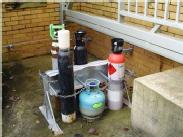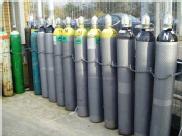Lab and Workshop Gases
Gas cylinders are used as a means of delivering specific gases throughout the University. They appear in styles and forms from cellar gas through to industrial and laboratory gases. Gas cylinders differ widely in capacity, size and shape. They all share the property of being constructed in very strong material, usually steel, to contain the gas at high pressures. The full pressure also varies depending on the type of gas and duty for the cylinder and pressures can be very high. Cylinders fall into two categories - liquefied gases and compressed gases.
There are hazards associated with the cylinders, the gases contained in the cylinders, the pipework and connections and the use of the gases. There are requirements for inspection and maintenance of gas delivery systems and guidance is available to help determine what is required. Gas cylinders pose risks in the event of a fire. The Fire Service may decide that gas cylinders pose a risk to their staff when considering how to tackle a fire.
The use of gases must be justified and supported by a suitable risk assessment. A generic risk assessment for the introduction of flammable gases into a work area is available to help decide on additional controls and requirements. Departments that need to obtain / use gas cylinders must register this with the health and safety department and must have arrangements for obtaining, holding, using and disposing of them.
Some useful Web links:
http://encyclopedia.airliquide.com/encyclopedia.asp?CountryID=19&LanguageID=11
http://www.intergas.co.uk/msdslib.html
 |
 |
| Gas cylinders in a typical gas storage compound |
They are secured to the stillage rails with chains. |
